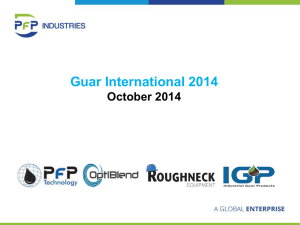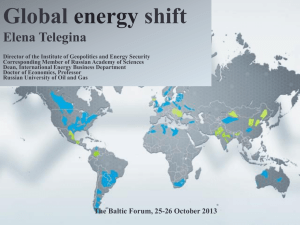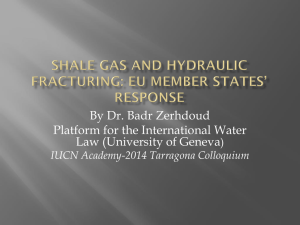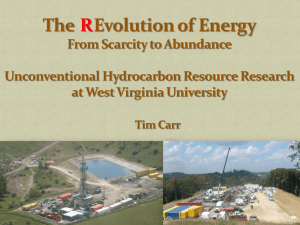Oil Shale Projects
advertisement
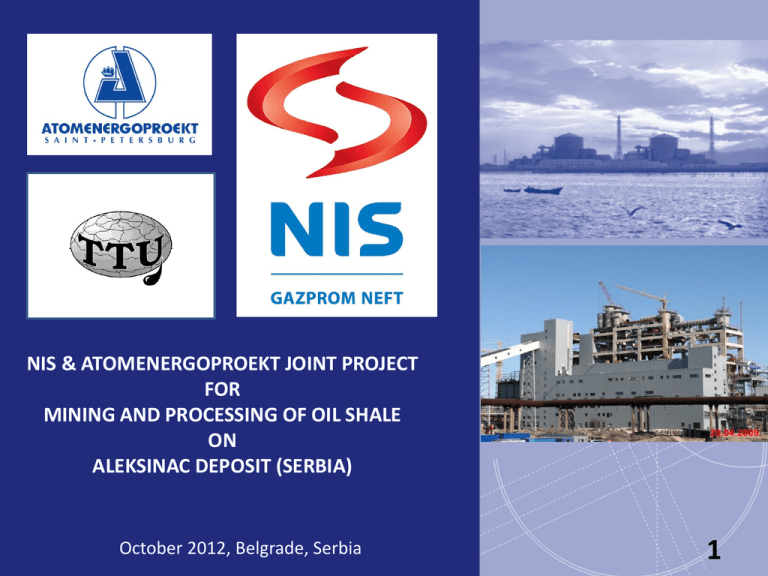
NIS & ATOMENERGOPROEKT JOINT PROJECT FOR MINING AND PROCESSING OF OIL SHALE ON ALEKSINAC DEPOSIT (SERBIA) October 2012, Belgrade, Serbia 1 Agenda 1. Introduction 2. NIS overview 3. ATOMENERGOPROEKT overview 4. TTU-Ltd overview 5. Benefits of joint participation 6. References in the field of oil shale 7. Current projects 8. UTT-3000 technology overview 9. Technology comparison 10. UTT-3000 advantages 11. Aleksinac project overview 12. UWB sounding for geological prospecting & exploration 2 Introduction • • • Global reserves of oil shale (in terms of oil) are many times larger than those of conventional oil. Estimates of global deposits range from 2.8 to 3.3 trillion barrels Estimates of Serbia deposits are 1.5 million barrels 3 NIS • One of the largest vertically integrated companies for the production of crude oil and gas in Southeast Europe • The company for exploration, production and refining of crude oil and natural gas as well as sales and distribution of a wide range of petroleum products • It possesses: • Crude oil and natural gas production • Refineries in Pancevo and Novi Sad • Own retail network • Energy business • Oilfield Services • Petrochemistry Indicator 2011 Revenues, bln RSD 187,05 EBITDA, bln RSD 52,39 Employees 9076* * Including NIS first chance Business center in Novi Sad 4 ATOMENERGOPROEKT • • • • OJSC "Saint-Petersburg Research and Design Institute ATOMENERGOPROEKT“ (JSC" SPbAEP ") established on September 1, 1929. 118 power plants, including 18 nuclear power plants in 19 countries were built and put into operation based on “SPbAEP” designs. The Institute has been involved in the oil shale industry since 1950s, has designed 3 oil shale fired power plants, and all existing UTT-3000 and UTT-500 ATOMENERGOPROEKT today has: • • • • more than 80 years of successful operation about 1800 highly experienced specialists projects successfully implemented in 19 countries certified quality management system ISO 9001 JSC “SPbAEP” head office 5 TTU-Ltd • • • • • TTU Ltd – company possessing method patents and installations for processing oil shale by solid heat carrier (UTT) Established by specialists in the field of oil shale processing in 2006, reorganized in 2009 Goal of the company – development and distribution of technology for the processing of low-calorific solid fuels by high speed pyrolysis method Galoter Number of patents – 24 Number of inventors involved – 37 6 Benefits of joint participation • • • NIS refining complex includes two individual locations: Pancevo and Novi Sad which are suitable for processing shale oil ATOMENERGOPROEKT has ultimate experience and exclusive rights to the design of UTT-3000 installations TTU-Ltd is the owner of patents and technology provider 7 References of ATOMENERGOPROEKT Oil shale based Power Facilities Oil shale based Power & Technological Facilities Ilmarine Factory Tallinn, 1950-53 UTT-50 facility with bunker-type and drumtype reactors 50 t oil shale / day (R&D) Kivioili Kivioili, 1953 R&D UTT-200 facility 200 t / day Kivioili Kivioili, 1963 R&D UTT-500 facility 500 t / day Oil Factory Narva, 1975-1980 Two commercial UTT-3000 facilities 6000 t / day Power Technological Plant Slantsy, 1994-2006 Project 3xUTT-3000 9000 t / day Viru Keemia Group Kohtla Yarve, 2006 Project 1xUTT-3000 3000 t / day 8 Estonian PP, Narva, 1969-73, 1610 MWe, 84 MWt Designed by ATOMENERGOPOEKT 9 Oil Factory 2хUTT-3000, Narva, 1980-84, 6660 tpd oil shale Today known as Enefit-140, designed by ATOMENERGOPOEKT 10 UТТ-3000 in Kohtla Jarve, VKG Oil AS Today known as Petroter , designed by ATOMENERGOPOEKT 11 ATOMENERGOPROEKT Current projects Nuclear Power Plants • 2xVVER-1200 Leningradskaya NPP-2 Saint Petersburg, Russia. • 2xVVER-1200 Baltic NPP Kaliningrad, Russia. • FN-800 Beloyarskaya NPP, Ekaterinburg, Russia. • 4xVVER-1000 Tianwan NPP, Tianwan, China. • VVER-1000 Busher NPP, Iran. • VVER-440 Kola NPP, Russia 12 ATOMENERGOPROEKT Current projects Oil Shale Projects • 18xUTT 3000 • 24xUTT 3000 • 24xUTT 3000 • 2xUTT 3000 • 8xUTT 3000 • 2xUTT 3000 • 2xUTT 3000 • 24xUTT 3000 • 24xUTT 3000 • 8xUTT 3000 El Lajun, Jordan Al Atarat, Jordan Bayer, Jordan Sultani, Jordan Bayer, Jordan Mishor Rotem, Israel Mishor Rotem, Israel Sangruntau, Uzbekistan Tichara, Myanmar Tarfaya, Morocco INCOSIN INCOSIN INTER RAO UES JOSECO GLOBAL OIL SHALE Co. INTER RAO UES GLOBAL OIL SHALE Co. UZBEKNEFTEGAZ SNOG Ltd. ZONA ENGINIRIE S.A.R.L. 13 The Essence of Processing Thermal decomposition of kerogen is the base of all oil shale processing methods. 100% Water Kerogen Maximum liquid yield can be achieved at the end point of thermobitumen decomposition . Coke 75% Thermobitumen 50% Oil fraction >350 0 Oil fraction 200-350 0 25% Oil fraction <200 0 Gas 0% 300 350 400 450 0C The higher the temperature the more coke and gas are formed. Heavy oil in conditions of tough permeability of fractured rock or in coarse fragmented shale is also condensed and polymerized forming coke and gas and lowering liquid yield. The point of total decomposition of thermobitumen varies for different kinds of oil shale as per temperature as well as per yield of coke which depends on H/C ratio. This is why in-situ heating process will never exceed energy efficiency 40-50% leaving carbon and heavy oil in-situ. 14 The Essence of Processing Thermal decomposition of kerogen is the base of all oil shale processing methods. 100% Water Kerogen Coke 75% Maximum liquid yield can be achieved at the end point of thermobitumen decomposition . Thermobitumen 50% Oil fraction >350 0 Oil fraction 200-350 0 25% Oil fraction <200 0 Gas 0% 300 350 400 450 0C The higher the temperature the more coke and gas are formed. Heavy oil in conditions of tough permeability of fractured rock or in coarse fragmented shale is also condensed and polymerized forming coke and gas and lowering liquid yield. The point of total decomposition of thermobitumen varies for different kinds of oil shale as per temperature as well as per yield of coke which depends on H/C ratio. This is why in-situ heating process will never exceed energy efficiency 40-50% leaving carbon and heavy oil in-situ. 15 UТТ-3000 Flowsheet 16 Balance scheme Raw Oil Shale 2,500 thsnd t (500 thsnd t.o.e.) Efficiency: On commodity products -80.0 % General (incl. own needs)-85.5% UTT-3000 installation outlet 456.4 thsnd t.o.e. Efficiency 91,3% Gas 101.7 thsnd t (82.5 thsnd t.o.e.) Medium oil 117.5 thsnd t (106.7 thsnd t.o.e.) Steam 900 thsnd t (56.7 thsnd t.o.e.) Electricity 374.2 mln kWh (32.2 thsnd t.o.e.) Electricity 203.6 mln kWh (17.5 thsnd t.o.e.) Diesel fraction 29.6 thsnd t (28.9 thsnd t.o.e.) Heavy oil 139.9 thsnd t (120.1 thsnd t.o.e.) Steam and heat 100,040 Gcal (10 thsnd t.o.e.) Petrol fraction 40.5 thsnd t (39.8 thsnd t.o.e.) Gas petrol 22 thsnd t (21.7 thsnd t.o.e.) Synthetic oil 350 thsnd t (317.3 thsnd t.o.e.) 17 Other known technologies Chevron Crush Shell ICP ATP Processor 18 Other known technologies Lurghi-Lurgas Process IGT Union B Kiviter / Fushun Petrosix 19 Technology comparison Final result show how much share of in-situ oil shale energy goes to the profit forming: PROFIT = Final result * Oil Shale Resource Energy in BOE * Oil Price Source: “RESOURCE- Evaluation Model for Choice of Oil Shale Mining and Processing Technologies “, 28th Oil Shale Symposium, October 13-17, 2008 20 UТТ-3000 Advantages 12.3.1.1. Comparison of participants of shale oil production market Capacity, bopd Unit capacity, tph Number of units Service life, year CAPEX, $ mln CAPEX per unit, $ mln CAPEX per bopd CAPEX $/bbl OPEX $/bbl Maturity of technology, years of units work Oil Shale, tpd Capacity Ratio Yield of oil bbl/t Products Syncrude, bopd pyrolysis distillates, bopd electricity, MWh/day sulfur, tpd tiophenes, tpd Prices Syncrude, $/bbl Pyrodistillates, $/bbl Electricity, S/MWh Sulfur, $/t Tiophenes, S/t Revenue, $ per day Syncrude Pyrodistillates Electricity Sulfur Tiophenes Total revenue, $ per day OPEX+CAPEX Profit, $ per day Payback period, year Payback (Oil + Electricity only), year Profitability of investments, % annual Share in production, % Enefit ATP UTT 38 000 280 10 30 (assumpted) 5 900 590 155 263 14,2 23,0 assumpted 0 new 53 760 0,8 0,7 15 000 500 2 30 (assumpted) 1 800 900 120 000 11,0 23,0 stated ~1 on oil shale 19 200 0,8 0,8 30 000 139 24 30 proved 1 900 79 63 333 5,8 20,0 stated 59 three UTT-3000 64 051 0,8 0,5 38 000 15 000 8400 387 960 153 30 000 14400 95 70 70 48 600 3000 48 600 3000 60 48 600 3000 2 660 000 403 200 232 013 3 295 213 1 412 813 1 882 400 8,6 9,8 12 46% 1 050 000 46 080 91 584 1 187 664 509 384 678 280 7,3 8,4 14 18% 1 800 000 691 200 286 200 2 777 400 773 516 2 003 884 2,6 3,0 38 36% Source: Marketing researches by TTU Ltd submitted to NRA, Jordan, 2010 21 Opportunities and Prospects • The opportunity of processing of hydrocarbonaceous wastes in UTT – used tires (up to 10% wt), oil soaked soils (20-25 % from volume of oil shale), tars, cakes, etc, will provide an additional output of liquid distillates • Shale oil can be used as the activator for processing the heavy oil residues (tar, malta, black oils). In thermal processes of heavy oil residue processing (visbreaking and thermocracking), application of oil shale activators increases the yield of light products from 20% up to 60%, and in hydrogenization processes (hydrocracking) the yield of light products for one cycle increases from 50% up to 90%, thus process speed is 2 times higher, and working pressure is 2 times lower. • The UTT installations can be added with oil&gas fired power plants with the capacity of up to 100 МW per unit. The opportunity of regulation of an output of liquid and gaseous products from UTT over a wide range allows the plant to be quickly switched from fuel production to electric power generation and to serve as peak smoothing power generation facility. • The UTT complex can be added with cement works - for the production of cement it is possible to use cement clinker produced from cyclonic shale ashes, limestone, fuel and energy. • UTT can be added with melting oven to melt ash – it will enable production of clinker and extract metals from ash. 22 Environmental Subject of Impact Source Contaminants Note, concentration Atmosphere Chimneys Dust Meets to EU norms SO2 Meets to EU norms CO Meets to EU norms CO2 Meets to EU norms Nox None Hydrocarbons Within allowed limits for refineries Ash Inert, solid, non-dusting Overburden FIlled back to exhausted space of quarry and reclaimed Soil Water Ash stock No leakages into environment Analogue: Operating plant Petroter based on UTT-3000 located in confines of Kohtla Jarve town in European Union. 23 Standard EE 0579981-NJ ST 9:2005 "Oil Factory Products" Products Specs Application Heavy oil 1040 kg/m3 Used for asphalt in road construction Heavy-medium fraction 1035-1050 kg/m3 Used as fuel oil in big boilers and power plants Total oil Grades A, B, C Pour point -10..-40 ºС 1010-890 kg/m3 Used in boilers of any capacity, does not require heating in winter time Shale fuel oil Grades L-1, L-2, L-3 880-1010 kg/m3 Used as light fuel oil in boilers, in gas turbines, for marine oil production Semi-coke gas 1.15 kg/m3 Used in boilers 24 Aleksinac oil shale deposit • The exploration area is located in the south-eastern part of Serbia. • Potential reserves (resources) of oil shale on the territory under exploration Aleksinac estimated at 2 billion tons. • Organic content up to 16.6% and an average oil content of 8.95%. Source: Project of geological exploration of Aleksinac deposit, NIS, 2010 25 Aleksinac oil shale deposit q Oil shale Brown coal Source: Project of geological exploration of Alecsinac deposit, NIS, 2010 26 Aleksinac oil shale deposit Geological section of the Aleksinac deposit Source: Project of geological exploration of Aleksinac deposit, NIS, 2010 27 Structure of proposed production Quarry Mining Oil Shale 5 mln tpy Retorting unit Distillation Unit Processing Oil Shale 5 mln tpy NIS refineries NIS pipeline, railroad Overburden Filling back 5 - 7 mln tpy Shale Oil 0,5 mln tpy Processing 5 mln tpy Gas 0,5 mln tpy & Recovered Heat 115,000 toe Turbine House Petrol, Diesel oil, Fuel Oil, Asphalt Electric power 1,600 mln kW-h (200 MW) 28 Shale oil as activator for heavy oil processing • • • • • Shale oil can be used as the activator for processing the heavy oil residues (tar, malta, black oils, thick crude) in oil refineries. In thermal processing of the heavy oil residues (visbreaking and thermocracking) application of oil shale activators increases the yield of light products from 20% up to 60%, and in hydrogenization processes (hydrocracking) the yield of light products for one cycle increases from 50% up to 90%, thus speed of process is 2 times higher, and working pressure is 2 times lower. Proper industrial test runs were made in Angarsk petrochemical plant. Use of 500 thousand ton of shale oil as activator in NIS refineries for processing 5 mln ton of crude oil will increase yield of petrol and diesel oil. 29 Proximate economic evaluation of Aleksinac project 5 mln tpy (8,600 bopd) 30 UWB sounding for further geological prospecting & exploration Elaborated method of impulse Ultra Wide Band Electro Magnetic Sounding (UWB) allows to find the oil shale layers and distinguish them by rich and poor grades. Risky costs of prospecting works are ten times lower in comparison to drilling. 31 UWB sounding for further geological prospecting & exploration 32 UWB sounding for further geological prospecting & exploration 33 Conclusion The Republic of Serbia, in partnership with NIS, Atomenergoproekt and TTU-Ltd possess all necessary resources, capacities, experience, funds, skills and access to technology required to implement the project of development of oil shale starting from Aleksinac deposit, and expanding the experience to other deposits, and to include oil shale into the energy balance, being friendly to the environment and for the benefit of the Serbian people. 34 Thank you! October 2012, Belgrade, Serbia 35

